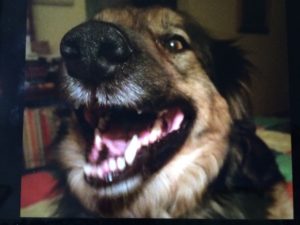
Say hello to Stella. She’s smiling because her people just checked her for lumps and bumps. Nothing here!
Cancer. Sadly, it can effect anyone, anytime. Even our pets. In fact, cancer accounts for almost 50 percent of all disease-related deaths in dogs and cats every year. (1)
But early detection can be the key to a successful outcome. And YOU are the key to that early detection. Take the time every month to give your best friend(s) a thorough examination, looking for anything unusual, like the signs below. If you find something, don’t wait. Visit your vet right away. Early detection, just like in people, can be the answer to successful treatment and a positive outcome.
The symptoms of pet cancer are not always obvious so watch for these signs and symptoms, as the sooner disease is detected, the better.
Pet Cancer Detection Tips
- Pale gums: Your pet’s gums should be just as pink as your own. Sudden blood loss can cause pale gums. Observe your healthy pet so you can determine a visual baseline of color.
- Distended belly: Gradual weight gain with age is common, however, you should not suddenly notice your dog has a large belly. Ruptured or growing tumors can cause a pet’s abdomen to suddenly appear enlarged.
- Sudden lethargy or collapse: While many dogs and cats slow down with age, sudden changes should not occur. Tumors can have side effects which make pets very sluggish. Sudden collapse is an emergency and can be caused by ruptured tumors. Seek veterinary attention immediately.
- Bleeding: If you see blood dripping from your pet’s nose or genital area, he or she needs to be evaluated for bleeding tumors or problems with making normal blood clots.
- Lumps and bumps: New lumps and bumps need to be evaluated to determine if they are benign or cancerous. Areas of particular concern are the lymph nodes, as they can grow larger from lymphoma or infection.
- Foul breath or bleeding from mouth: Aging pets can have unpleasant breath, however, their breath should not be horrible. Tumors growing in the mouth can trap food and bacteria, resulting in secondary infections and foul breath. Watch for difficulty eating (prolonged chewing, unwillingness to chew, or food falling from the mouth) as well as bleeding after eating, drinking or chewing toys.
- Difficulty urinating: While simple urinary tract infections can cause increased urgency of urination in small amounts, bladder tumors or stones can interfere with the ability to urinate. Urinary problems are urgent.
- Anorexia: Cats and dogs that stop eating usually have a health problem. There are many reasons for decreased appetite, however, cancer is one of them, particularly in elderly pets.
- Insatiable thirst: Dogs should consume the same amount of water each day, with exceptions of hot days or after exercise.
- Vomiting: Similar to anorexia, vomiting occurs for many reasons at any age. Frequent vomiting is a problem not to be ignored at any age.
- Limping: Many pets get stiff with age and can limp shortly after vigorous activity. Limping that persists for more than a week must be medically evaluated to determine if it is from bone cancer, infection, arthritis or other health problem.
- Nasal discharge: Vaccinated adult pets do not usually get frequent sinus/nasal infections. Tumors in the sinuses can result in repeated sinus infections.White, green or yellow discharge from the nose is not normal.
Make checking your pet for lumps, bumps, and any unusual signs a part of your monthly routine. You best friend will love the added attention and you can be a proactive partner in your pet’s best health!
(1) (Source)








